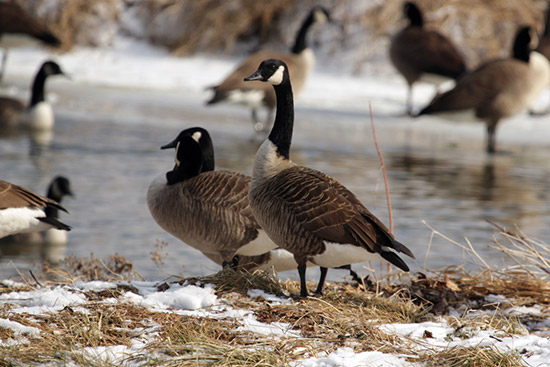More wintering waterfowl counted in Maryland in 2013
Both Canada geese and snow geese were more abundant during the latest Midwinter Waterfowl Survey.

This winter saw an increase in waterfowl along Maryland’s Chesapeake Bay shoreline and Atlantic coast.
While pilots and biologists from the U.S. Fish and Wildlife Service (USFWS) and Maryland Department of Natural Resources (DNR) counted fewer diving and dabbling ducks this winter than they did in the 2012 Midwinter Waterfowl Survey, these same crews counted more geese.
According to a DNR news release, both Canada geese and snow geese were “noticeably more abundant during this year’s survey,” with crews counting 462,000 Canada geese—a three-year high—and 83,300 snow geese—a five-year high. Biologists have attributed the boost in goose numbers to two factors: last spring’s successful nesting season and December snow cover in New York and southern Canada, which encouraged geese to migrate into the Bay region right before the survey was taken.
While more geese could mean more damage to area farms—as the birds forage on green cover crops and grain crops—most farmers “have learned to deal with the problem,” said Larry Hindman, wildlife biologist and Waterfowl Project Leader with DNR. Fluttering plastic flags, bald eagle effigies placed in the middle of fields and the loud bang of a rifle or shotgun have all proven effective at deterring persistent geese, Hindman said, and those farmers who need extra help can find assistance and advice in the U.S. Department of Agriculture’s Wildlife Damage Management program.

Resident Canada geese can pose a problem for rural, suburban and urban residents alike, and are considered overabundant in the region. While the birds do provide hunters with a chance for recreation, resident geese can overgraze wetlands and lawns and leave their droppings to pollute local rivers and streams. While the Midwinter Waterfowl Survey does not make a distinction between resident and migratory geese—as both stocks look the same during an aerial survey—DNR researchers do monitor the resident population using leg bands recovered from hunters.
The Midwinter Waterfowl Survey is used as an index of long-term wintering waterfowl trends. The estimates measure waterfowl populations along the Atlantic Flyway, which is a bird migration route that follows North America’s Atlantic Coast and Appalachian Mountains.
Read the full waterfowl survey results on the DNR website.

Comments
There are no comments.
Thank you!
Your comment has been received. Before it can be published, the comment will be reviewed by our team to ensure it adheres with our rules of engagement.
Back to recent stories